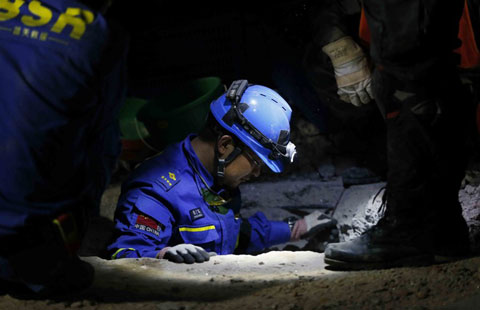China loves almonds from water-thirsty California
Updated: 2015-04-23 04:24
By William Hennelly(China Daily USA)
|
||||||||
The demand for California almonds from places like China is running smack into the drought-plagued state's water politics.
In a state known for its activism, a multibillion-dollar farm industry is pitted against environmental concerns. It's not so much an issue of whether California has enough water, it's a matter of how that water is managed and used.
Almonds soak up more water than all indoor household use by California's 39 million residents, according to The Associated Press. Governor Jerry Brown recently ordered a 25 percent cut in urban water usage, as the state sits in a fourth straight year of drought.

Eighty percent of California's water goes to its massive agricultural industry. The land covered by almond trees has grown from 640,000 acres in 2004 to more than 1 million today.
California's almond and pistachio farms required 1.2 trillion gallons of water in 2010, up from 575 billion in 1998, according to the California Department of Water Resources.
Each almond is said to require a gallon of water to grow. But the Almond Board of California, a trade group, said that over the past two decades, growers have used advances in irrigation to cut the water needed to grow almonds on average by 33 percent.
California exported $3.5 billion worth of almonds in 2014, an increase of 10.8 percent over 2013, according to the US Census Bureau. Almonds are the state's No 1 food export, and California produces 80 percent of the world's almonds.
Almonds are in demand for their many health benefits: they're high in protein, fiber, antioxidants, monounsaturated fat (a good one) and are gluten free. Almond milk and butter also are popular with consumers.
Global consumption of California almonds has risen more than 1,000 percent in the last decade, with China's middle class driving much of the demand. California almonds (ban dan mu in Mandarin) are a popular bagged treat in China's convenience stores and supermarkets and a desired item in holiday gift baskets.
Almond cookies are a staple during Lunar New Year season. California shipped 236 million pounds of almonds to China during the crop year ended in July 2012, according to the Almond Board.
The Asia market is creating up to 30 percent returns for investors, the AP reported. That has led to agribusinesses increasing almond planting in California by two-thirds in the past decade. Multinational corporations and investment funds now are heavily involved in almond growing.
Almond farmer Lynn Barris, whose husband, Tim, manages a 450-acre almond farm in Durham, about 170 miles northeast of San Francisco, says the numbers given for almonds' water demands lump all parts of the state together. The north does not require irrigation, but more arid parts of the state do.
"There are farms around here that have been growing almonds for more than 100 years," she told China Daily. "I'm not against anybody making money, but not when it's unsustainable."
The Barrises also have their own 12-acre almond farm; both farms belong to the Blue Diamond Growers cooperative in Sacramento, the largest tree-nut processing company in the world.
It's "not a simple issue because we all love almonds", Conner Everts, co-facilitator of the Environmental Water Caucus in Santa Monica, told China Daily. "But where and how almonds are grown makes a difference, and to the north, natural rainfall sustains (the crop) through the winter and spring with fertile soils.
"The problematic areas of vast overplantings on toxic soils with only imported water for irrigation are on the west side of the southern San Joaquin (Valley) and are industrial in acreage and practices," he said.
Everts said that those areas are "dry, desert lands with tumbleweeds, but add cheap water, often only at the price of pumping or extracted from a once beautiful estuary, and you have an unsustainable situation. And almonds are not the most water-thirsty crop; look to cotton, rice and especially alfalfa".
There's also the issue of groundwater depletion. California landowners can drop a well anywhere, according to Grist.org, a Seattle-based environmental news website.
"To get a right to groundwater, you simply extract the water and use it for a beneficial purpose," the State Water Resources Control Board says on its website. Farming is a beneficial purpose.
Between 2003 and 2010, farms in California's Central Valley have drawn down aquifers by 20 cubic kilometers — enough to meet the household water needs of New York City for 11 years, according to Grist.
Everts said the dearth of the Sierra Nevada mountains' snowpack this year also has reduced the water supply. Come the end of the summer, it could be time for the governor and all interested parties to sit down and coordinate water use in the state, he said.
Contact the writer at williamhennelly@chinadailyusa.com
- Tourists swarm Mount Taishan even before holiday
- Hospitals checked for possible bribes, kickbacks, misconduct
- 2,000 Chinese tourists return from Nepal
- Watchdog says Sinopec chief faces investigation
- Red Cross Society of China delivers relief supplies to Nepal
- 4,000 Chinese stranded in quake-hit Nepal

 'Comfort women' survivor attends protest of Jpapan PM
'Comfort women' survivor attends protest of Jpapan PM
 Ten photos you don't wanna miss – April 29
Ten photos you don't wanna miss – April 29
 China's rescue team searches for survivors in Nepal
China's rescue team searches for survivors in Nepal
 Police descend on Baltimore to enforce curfew after riots
Police descend on Baltimore to enforce curfew after riots
 Top 10 Chinese cities with innovative flair
Top 10 Chinese cities with innovative flair
 Tourists swarm Mount Taishan even before holiday
Tourists swarm Mount Taishan even before holiday
 Man pulled alive from rubble 82 hours after quake
Man pulled alive from rubble 82 hours after quake
 Baltimore erupts in riots after funeral of man who died in police custody
Baltimore erupts in riots after funeral of man who died in police custody
Most Viewed
Editor's Picks

|

|

|

|

|

|
Today's Top News
US rapped for stance on Japan
Obama, Abe talk much about China
Japan PM protested at US Capitol, San Francisco
Chinese students caught in riot scene
China hits out as Abe visits the US
Riot-hit Baltimore, an American city divided by income and opportunity
Record shattered as Furious 7 sets hot pace
'Rent-a-Foreigner' business by China's real estate developers
US Weekly

|

|







